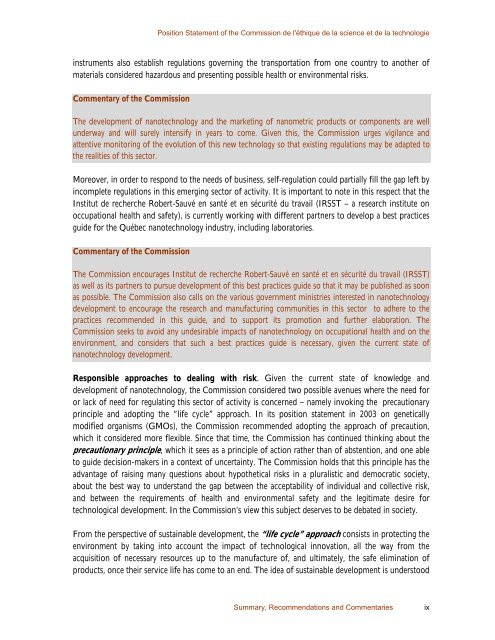A Basis for Action - Commission de l'éthique de la science et de la ...
A Basis for Action - Commission de l'éthique de la science et de la ...
A Basis for Action - Commission de l'éthique de la science et de la ...
You also want an ePaper? Increase the reach of your titles
YUMPU automatically turns print PDFs into web optimized ePapers that Google loves.
Position Statement of the <strong>Commission</strong> <strong>de</strong> l'éthique <strong>de</strong> <strong>la</strong> <strong>science</strong> <strong>et</strong> <strong>de</strong> <strong>la</strong> technologie<br />
instruments also establish regu<strong>la</strong>tions governing the transportation from one country to another of<br />
materials consi<strong>de</strong>red hazardous and presenting possible health or environmental risks.<br />
Commentary of the <strong>Commission</strong><br />
The <strong>de</strong>velopment of nanotechnology and the mark<strong>et</strong>ing of nanom<strong>et</strong>ric products or components are well<br />
un<strong>de</strong>rway and will surely intensify in years to come. Given this, the <strong>Commission</strong> urges vigi<strong>la</strong>nce and<br />
attentive monitoring of the evolution of this new technology so that existing regu<strong>la</strong>tions may be adapted to<br />
the realities of this sector.<br />
Moreover, in or<strong>de</strong>r to respond to the needs of business, self-regu<strong>la</strong>tion could partially fill the gap left by<br />
incompl<strong>et</strong>e regu<strong>la</strong>tions in this emerging sector of activity. It is important to note in this respect that the<br />
Institut <strong>de</strong> recherche Robert-Sauvé en santé <strong>et</strong> en sécurité du travail (IRSST – a research institute on<br />
occupational health and saf<strong>et</strong>y), is currently working with different partners to <strong>de</strong>velop a best practices<br />
gui<strong>de</strong> <strong>for</strong> the Québec nanotechnology industry, including <strong>la</strong>boratories.<br />
Commentary of the <strong>Commission</strong><br />
The <strong>Commission</strong> encourages Institut <strong>de</strong> recherche Robert-Sauvé en santé <strong>et</strong> en sécurité du travail (IRSST)<br />
as well as its partners to pursue <strong>de</strong>velopment of this best practices gui<strong>de</strong> so that it may be published as soon<br />
as possible. The <strong>Commission</strong> also calls on the various government ministries interested in nanotechnology<br />
<strong>de</strong>velopment to encourage the research and manufacturing communities in this sector to adhere to the<br />
practices recommen<strong>de</strong>d in this gui<strong>de</strong>, and to support its promotion and further e<strong>la</strong>boration. The<br />
<strong>Commission</strong> seeks to avoid any un<strong>de</strong>sirable impacts of nanotechnology on occupational health and on the<br />
environment, and consi<strong>de</strong>rs that such a best practices gui<strong>de</strong> is necessary, given the current state of<br />
nanotechnology <strong>de</strong>velopment.<br />
Responsible approaches to <strong>de</strong>aling with risk. Given the current state of knowledge and<br />
<strong>de</strong>velopment of nanotechnology, the <strong>Commission</strong> consi<strong>de</strong>red two possible avenues where the need <strong>for</strong><br />
or <strong>la</strong>ck of need <strong>for</strong> regu<strong>la</strong>ting this sector of activity is concerned – namely invoking the precautionary<br />
principle and adopting the “life cycle” approach. In its position statement in 2003 on gen<strong>et</strong>ically<br />
modified organisms (GMOs), the <strong>Commission</strong> recommen<strong>de</strong>d adopting the approach of precaution,<br />
which it consi<strong>de</strong>red more flexible. Since that time, the <strong>Commission</strong> has continued thinking about the<br />
precautionary principle, which it sees as a principle of action rather than of abstention, and one able<br />
to gui<strong>de</strong> <strong>de</strong>cision-makers in a context of uncertainty. The <strong>Commission</strong> holds that this principle has the<br />
advantage of raising many questions about hypoth<strong>et</strong>ical risks in a pluralistic and <strong>de</strong>mocratic soci<strong>et</strong>y,<br />
about the best way to un<strong>de</strong>rstand the gap b<strong>et</strong>ween the acceptability of individual and collective risk,<br />
and b<strong>et</strong>ween the requirements of health and environmental saf<strong>et</strong>y and the legitimate <strong>de</strong>sire <strong>for</strong><br />
technological <strong>de</strong>velopment. In the <strong>Commission</strong>’s view this subject <strong>de</strong>serves to be <strong>de</strong>bated in soci<strong>et</strong>y.<br />
From the perspective of sustainable <strong>de</strong>velopment, the “life cycle” approach consists in protecting the<br />
environment by taking into account the impact of technological innovation, all the way from the<br />
acquisition of necessary resources up to the manufacture of, and ultimately, the safe elimination of<br />
products, once their service life has come to an end. The i<strong>de</strong>a of sustainable <strong>de</strong>velopment is un<strong>de</strong>rstood<br />
Summary, Recommendations and Commentaries<br />
ix
















